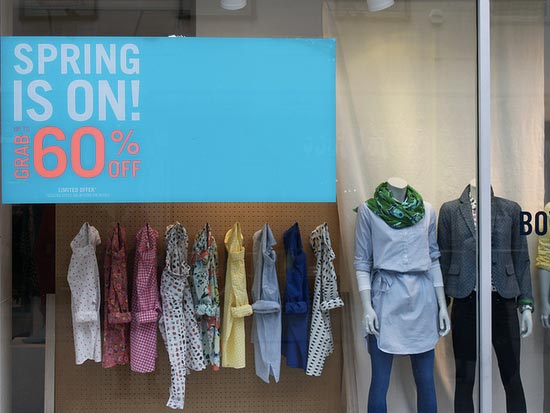Transactional utility is a term to describe the happiness a consumer gets from the perceived value of the deal. ‘Transactional utility’ was developed by Richard Thaler and is said to be the difference between the actual price and your reference price – the price you expect to pay.
Example, Suppose you expect to pay $50 for a new coat. However, when you go into the shop, you find there is an unexpected sale of 20%. Therefore, the price you actually pay is $40. You gain the utility of buying the new coat, but you also gain a transactional utility because you feel like you have saved $10 from your expected reference price.
This trick of sales and discounts can encourage us to buy clothes we never expected to. The sale makes the whole transaction more desirable
Transactional utility and Prospect Theory
Transactional utility is derived from D. Kahneman and A. Tversky‘s Prospect Theory. (1979) This theory states that people are affected by relative changes from a reference point – with losses being felt more strongly than gains.
“A simple way of incorporating the terms of the transaction is suggested Using the features of Kahneman and Tversky’s prospect theory. The new concept transaction utility is modeled as depending the difference between the selling price and a reference price.”
Richard Thaler (1983) ,”Transaction Utility Theory.”
Examples of Transactional utility
Richard Thaler uses this example of discounts on goods, to show how perceptions of transactional utility can influence our decisions.
- Suppose you are going to buy a cheap radio at one shop it is $35. But, 20 minutes away you can buy the same radio for $25.
- Suppose you are going to buy a new colour tv and it costs $640. But, 20 minutes away, you can buy the same tv for $630.
Do you drive 20 minutes to save $10 on the two products?
- Many consumers would buy the cheaper radio, but would not bother to travel to get the cheaper tv. Even though the amount saved – $10 is the same.
- One reason is transactional utility. The radio is nearly 30% discount – giving a large perceived transactional utility to buy the cheaper radio. The TV is only 1.5% cheaper so the transactional utility of saving $10 out of $640 feels much less.
Another question – Buying expensive products
Suppose you are thirsty at the airport, and someone offers you a bottle of water for $6. The marginal utility of the water is greater than the $6. However, despite being really thirsty, this transaction creates significant negative transactional utility because you know $6 for a bottle of water is much higher than your usual reference price for water.
Implications of transactional utility
- We may not buy a product, even if value is greater than market price (we dislike feeling of being ripped off)
- A reason why football clubs and sports stars may sell tickets below market price. Market clearing price to see Manchester United may be £200, but the perceived fair market price is £80.
- For a monopoly to charge higher prices than usual, they should try to differentiate the product from our usual reference price. For example, cinemas sell popcorn at inflated prices (above market price). To compensate they sell super-sized containers, so it isn’t an exact reference for consumers. We know the price is inflated, but the product is slightly different so we can justify it.
- Firms use very high suggested retail prices. For example, in the furniture industry it has become standard practice to sell at discounts of 40-80% of ‘initial suggested retail price’.
Personal examples of transactional utility
At airports, your water bottle is taken at security. Therefore, when I go through security, I want to buy a bottle of water for the long flight home. It is important to remain hydrated as I once got a blood clot on a transatlantic flight.
But, at JFK airport, water bottles are very expensive like $5 to $6. This makes it hard for me to buy. I always spend time looking through different shops to see if I can find a water bottle at my expected price of $1 (but never do). I guess if I see a bottle for $6 and get one for $5, I feel at least I’ve made a saving. But, there is a subconscious reluctance to pay $5 for water, when most forms of water are in theory a ‘free good.’
I like the concept of transactional utility because it is such a significant feature of consumer behaviour. It seems obvious when explained, yet for over 100 years, it was absent from traditional theories of marginal utility which over-emphasised the price only.
***
Utility measures the value we receive from buying a good or service. In traditional economic theories, the best measure of utility is the price we are willing to pay for the good.
Related
Richard Thaler (1983) ,”Transaction Utility Theory“, in NA – Advances in Consumer Research Volume 10, eds. Richard P. Bagozzi and Alice M. Tybout, Ann Abor, MI : Association for Consumer Research, Pages: 229-232.

